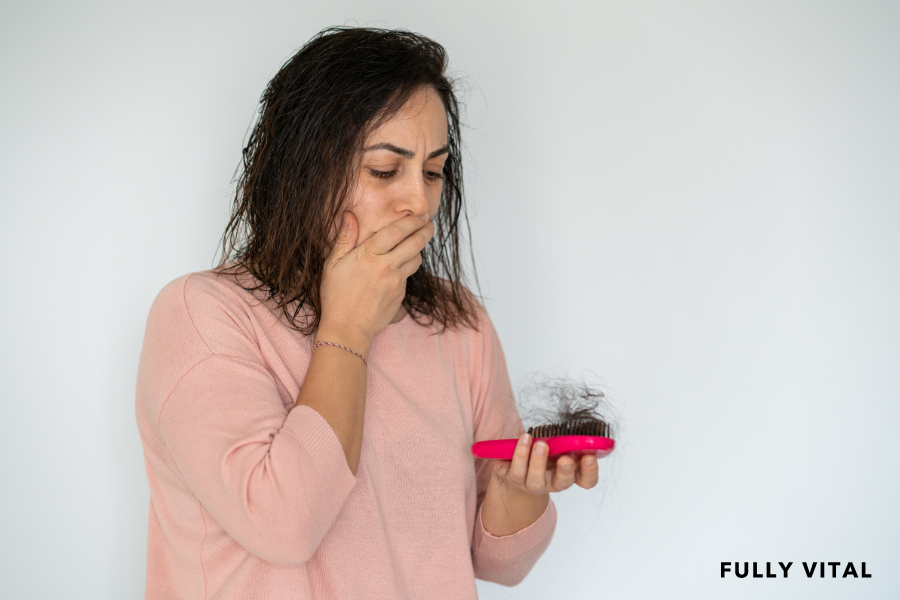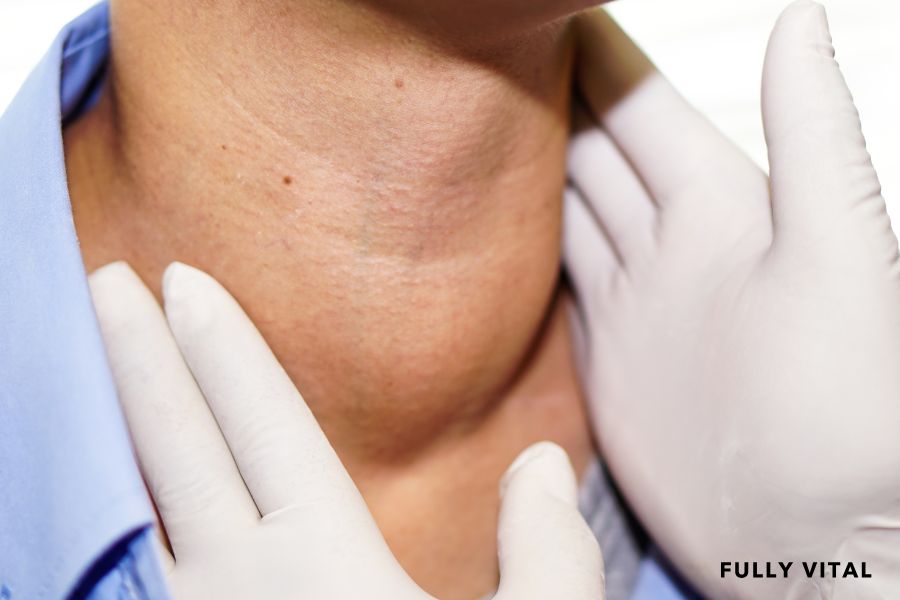
Postpartum Alopecia: Understanding, Treatment, And Management
Welcome to our comprehensive guide on postpartum alopecia – a common concern among women of all hair types who are looking to stimulate hair growth after pregnancy.
In this article, we'll delve into the essential aspects of postpartum alopecia, its causes, benefits of treatment, potential downsides, alternatives for management, and address frequently asked questions.
Our goal is to provide you with a conversational yet informative resource that covers all your queries regarding this topic.

I LOVE MY HAIR NOW
FullyVital hair serum and hair vitamins made tremendous improvements in my hair. I truly love my hair now.
Dorit S.,
What Is Postpartum Alopecia?
Postpartum alopecia refers to the temporary hair loss that some women experience after giving birth.
It's a natural physiological response and is mainly attributed to hormonal fluctuations.
During pregnancy, elevated hormone levels prolong the growth phase of hair, resulting in lush locks.
However, once hormone levels decrease after childbirth, hair can enter a resting phase, leading to noticeable hair shedding.

Why Is Understanding Postpartum Alopecia Important?
Understanding postpartum alopecia is crucial for new mothers as it empowers them to navigate the temporary hair loss that often follows childbirth.
By comprehending the hormonal shifts causing this phenomenon, women can take proactive steps to manage the shedding and boost their confidence.
Armed with this knowledge, they can explore effective hair growth products and strategies, making informed decisions to restore their hair's health and vitality.
How Does Postpartum Alopecia Occur?
Postpartum alopecia occurs due to hormonal changes experienced after childbirth.
While pregnant, elevated levels of hormones like estrogen prolong the growth phase of hair, leading to reduced hair shedding.1
After giving birth, hormone levels plummet, causing hair to enter a resting phase.
This shedding, while distressing, is a temporary phase as hormone levels gradually stabilize.
What Are the Benefits Of Treating Postpartum Alopecia?
Treating postpartum alopecia can offer several benefits:
Boosted Confidence
Addressing postpartum hair loss can help boost self-esteem and confidence during an emotionally vulnerable period.
Faster Recovery
Effective treatments can expedite the regrowth process, allowing women to regain their pre-pregnancy hair sooner.
Reduced Stress
Minimizing hair loss concerns can contribute to reduced stress and better emotional well-being.
Are There Any Downsides In Treating Postpartum Alopecia?
While treating postpartum alopecia can have numerous benefits, it's essential to consider potential downsides:
-
Expense: Some treatments might involve costs, which could be a concern for some women.
-
Effectiveness Variability: The effectiveness of treatments can vary from person to person, and there's no one-size-fits-all solution.
What Are The Alternatives To Postpartum Alopecia Management?
If you're looking for alternatives to managing postpartum alopecia, consider these options:
-
Hairstyling: Experiment with hairstyles that give the appearance of thicker hair.
-
Hair Care Routine: Opt for hair care products designed to add volume and improve hair health.
-
Nutrition: Consume a balanced diet rich in hair-nourishing nutrients like vitamins, minerals, and proteins.
Can Postpartum Cause Alopecia?
Yes, postpartum can cause a temporary condition known as postpartum alopecia.
This condition is characterized by hair loss in women after childbirth.
It's a natural response to hormonal changes that occur during and after pregnancy.
While distressing, it's important to understand that this hair loss is usually temporary and resolves on its own.
What Causes Postpartum Alopecia?
Postpartum alopecia is primarily caused by hormonal fluctuations that happen during pregnancy and after childbirth.
During pregnancy, increased levels of hormones like estrogen prolong the hair growth phase.
After giving birth, hormone levels drop, leading to hair entering a resting phase and subsequent shedding.
This is a normal process and not a cause for major concern.
When Does Postpartum Alopecia Start?
Postpartum alopecia typically starts around three months after childbirth.
This timing aligns with the natural hair growth cycle.
It's important to note that every woman's experience may vary.
Some might notice hair shedding earlier or later than the three-month mark.2
What Does Postpartum Alopecia Look Like?
Postpartum alopecia presents as a temporary but noticeable increase in hair shedding, often causing concern among new mothers.
While the extent of shedding can vary, here's what you might observe:
-
Increased Hair Fall: You might notice more hair strands on your pillow, in the shower drain, and on your hairbrush.
-
Thinning Hair: Your hair might appear thinner, especially around the crown and temples.
-
Widening Part: The part in your hair might look wider due to reduced hair density.
-
Visible Scalp: While not extreme, some women notice a bit more of their scalp becoming visible.
-
Short Hairs: Along with shedding, you might see shorter, finer hairs growing in. These are new hairs starting to regrow.
How Do You Treat Postpartum Alopecia?
While postpartum alopecia is a temporary phase, there are strategies to manage its effects:
Healthy Lifestyle
Maintain a balanced diet rich in vitamins and minerals that support hair health.
Gentle Hair Care
Be gentle with your hair to avoid additional stress on hair follicles.
Consider Hair Care Products
Use hair care products formulated to strengthen hair and promote growth.
Consult a Professional:
If you're concerned, consult a dermatologist or healthcare provider for personalized advice.
Remember, postpartum alopecia is a common experience and doesn't require immediate medical intervention.
In most cases, hair will regrow naturally as hormone levels stabilize.
What Is The History Of Postpartum Alopecia?
-
Ancient Beliefs: Historical records indicate that ancient civilizations were aware of postpartum hair loss.Remedies and rituals were often practiced to counter its effects.
-
Limited Solutions: Throughout history, women had limited access to effective treatments, relying on traditional remedies and practices.
-
Scientific Advancements: In recent decades, scientific understanding of hormonal changes and hair growth has led to the development of more targeted solutions.
What Is The Current Landscape Of Postpartum Alopecia?
-
Awareness and Acceptance: Today, women are more informed about postpartum alopecia, reducing unnecessary anxiety and distress.
-
Growing Market: The hair growth product industry has recognized the unique needs of postpartum women and is offering specialized solutions.
-
Holistic Approach: Companies are focusing on comprehensive care, combining products with nutrition and self-care recommendations.
What Is The Future Of Postpartum Alopecia?
-
Personalized Solutions: Advancements in genetics and personalized medicine may lead to tailored treatments for postpartum hair loss.
-
Technological Innovation: Technologies like laser therapy and advanced formulations could revolutionize postpartum alopecia management.3
-
Empowerment: As conversations around postpartum health expand, women are empowered to seek solutions and demand effective products.
Experience Youthful Locks With Fully Vital!Unlock the secret to vibrant, age-defying hair with Fully Vital's cutting-edge hair growth products. Our mission is to empower you on your hair journey, offering science-backed solutions that halt and even reverse the aging of your hair.
With Fully Vital, you hold the key to nurturing a more wholesome relationship with your hair. Turn back the clock on hair aging and embark on a journey of renewed confidence. |
Final Thoughts On Postpartum Alopecia
In wrapping up our exploration of postpartum alopecia, we've delved into the intricacies of this common phenomenon that affects many new mothers.
By understanding the causes, effects, and management of postpartum hair loss, you're better prepared to navigate this transitional period with assurance.
At Fully Vital, we recognize the significance of this topic for women of all hair types.
Our mission is to empower you to maintain a positive and healthy relationship with your locks.
Through our diverse range of hair growth products, we aim to provide effective solutions that address the challenges of postpartum alopecia and the aging of your hair.
Remember, postpartum hair loss is a temporary phase, and with the right care and products, you can optimize your hair's natural regrowth process.
While it's a common concern, it's also an opportunity to embrace the beauty of transformation.
As you continue your hair care journey, know that Fully Vital is here to support you every step of the way. Stay informed, stay confident, and nurture your locks with the care they deserve.
Frequently Asked Questions About Postpartum Alopecia
How long does postpartum alopecia typically last?
Postpartum alopecia is usually temporary, with most women noticing significant regrowth within a year after childbirth.
Can breastfeeding worsen postpartum alopecia?
Breastfeeding can contribute to hormonal fluctuations but isn't a primary cause of postpartum alopecia.
It's mainly driven by hormonal changes after giving birth.
Will postpartum alopecia affect future pregnancies?
No, postpartum alopecia doesn't have a long-term impact on future pregnancies or hair growth patterns.
Are hair supplements effective in preventing postpartum alopecia?
Hair supplements can be beneficial if they contain essential nutrients for hair health, but they might not entirely prevent postpartum alopecia.
Consult a healthcare professional before starting any supplements.
Are there preventive measures for postpartum alopecia?
While you can't entirely prevent postpartum alopecia, maintaining a healthy lifestyle, balanced diet, and managing stress can support overall hair health.
How long should I wait before seeking medical advice for postpartum alopecia?
If you're concerned about the extent of hair loss or if it's causing significant distress, it's wise to consult a healthcare provider or dermatologist.
They can provide personalized guidance and rule out any underlying issues.
Can postpartum alopecia lead to permanent baldness?
No, postpartum alopecia doesn't usually lead to permanent baldness.
The shedding is temporary and related to hormonal changes.
Hair typically regrows as hormones stabilize.
Is it normal to have postpartum alopecia after miscarriage?
Yes, hormonal changes during pregnancy, including miscarriage, can trigger postpartum alopecia.
The extent of shedding might vary, but it's generally a temporary condition.
Can I use my regular hair care products during postpartum alopecia?
Using gentle hair care products is advisable during postpartum alopecia.
Harsh chemicals can stress hair follicles.
Consider products that promote hair health and thickness.
When should I expect to see regrowth after postpartum alopecia?
Regrowth can vary, but most women notice significant improvement within a year after childbirth.
It's a gradual process, and patience is key.
Sources:
-
Piérard-Franchimont, C., & Piérard, G. E. (2013). Alterations in Hair Follicle Dynamics in Women. BioMed Research International, 2013, 957432. https://doi.org/10.1155/2013/957432
-
Postpartum Hair Loss: Causes, Treatment & What to Expect. (n.d.). Cleveland Clinic. Retrieved August 29, 2023, from https://my.clevelandclinic.org/health/diseases/23297-postpartum-hair-loss
-
van Zuuren, E. J., Fedorowicz, Z., & Schoones, J. (2016). Interventions for female pattern hair loss. Cochrane Database of Systematic Reviews. https://doi.org/10.1002/14651858.cd007628.pub4







